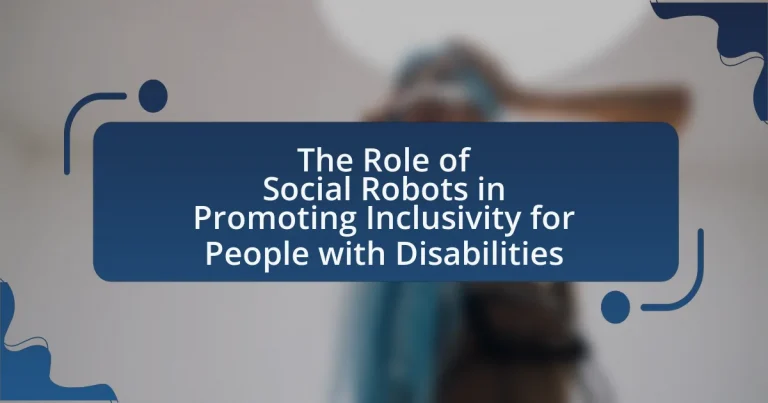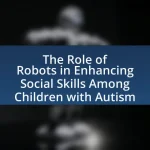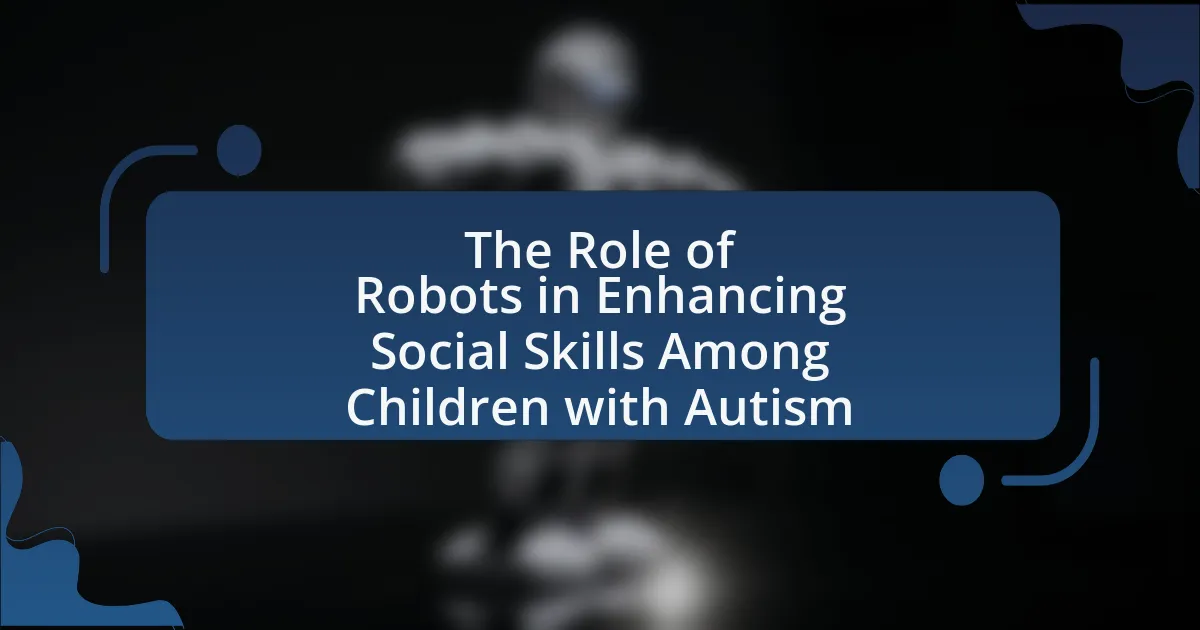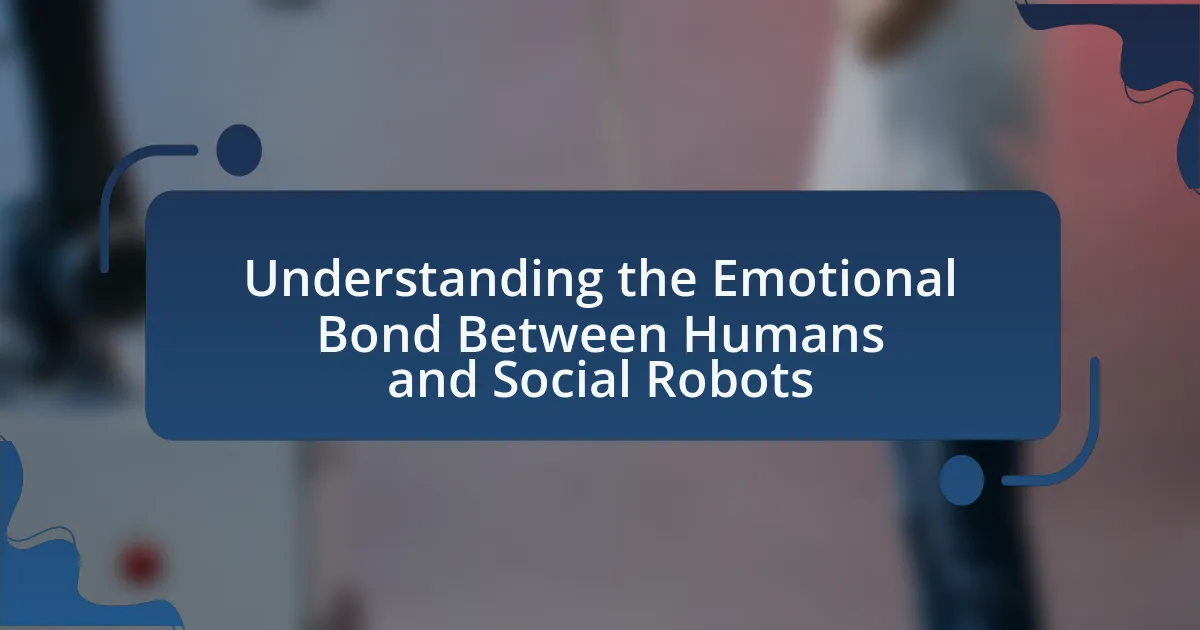Social robots are increasingly recognized for their role in promoting inclusivity for people with disabilities by providing companionship, assistance, and facilitating social interactions. These robots, such as PARO and Buddy, enhance communication skills, reduce feelings of isolation, and support daily living activities for individuals with various disabilities. The article explores how social robots assist individuals, the specific tasks they perform, and the importance of inclusivity for mental health and social integration. Additionally, it addresses the challenges and limitations faced by social robots, the ethical considerations involved, and the advancements needed to improve their effectiveness in fostering inclusivity.
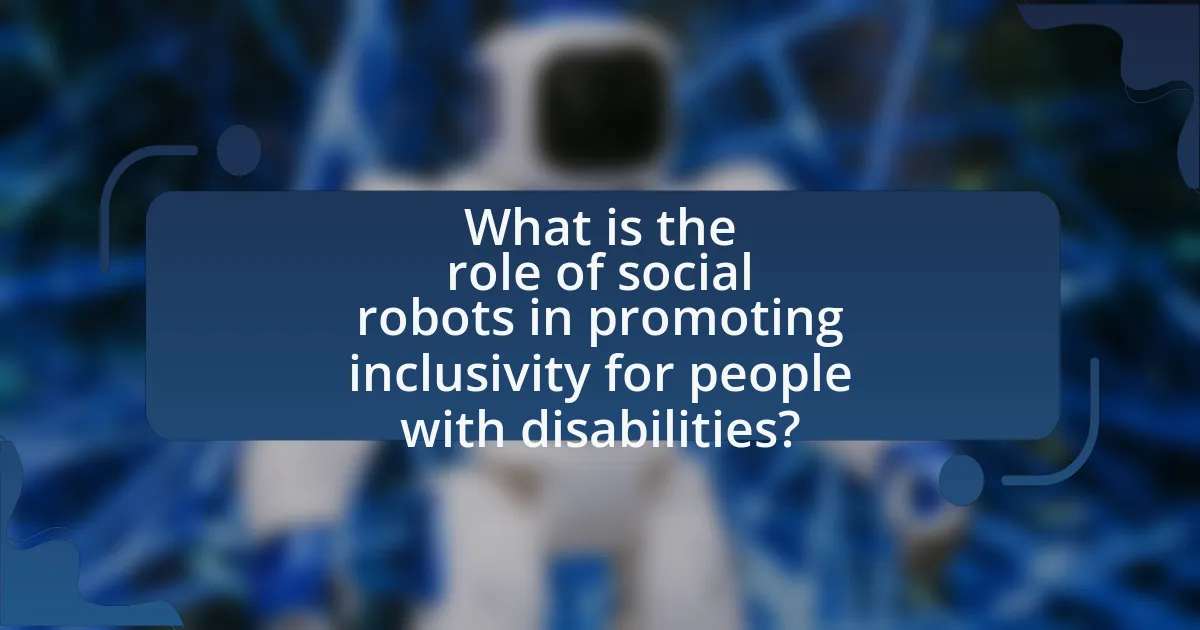
What is the role of social robots in promoting inclusivity for people with disabilities?
Social robots play a crucial role in promoting inclusivity for people with disabilities by providing companionship, assistance, and facilitating social interactions. These robots can be programmed to engage users in meaningful conversations, helping to reduce feelings of isolation often experienced by individuals with disabilities. For instance, studies have shown that social robots like PARO, a therapeutic robot designed to resemble a baby seal, have been effective in improving emotional well-being and social engagement among elderly individuals with cognitive impairments. Additionally, robots such as Buddy and NAO have been utilized in educational settings to assist children with autism, enhancing their communication skills and social interactions. The integration of social robots in various environments demonstrates their potential to foster inclusivity and improve the quality of life for people with disabilities.
How do social robots assist individuals with disabilities?
Social robots assist individuals with disabilities by providing companionship, enhancing communication, and facilitating daily tasks. These robots can engage users through interactive conversations, which helps reduce feelings of isolation and loneliness often experienced by individuals with disabilities. For example, studies have shown that social robots like PARO, a therapeutic robot seal, can improve emotional well-being and social interaction among elderly individuals with cognitive impairments. Additionally, robots equipped with assistive technologies can help users perform tasks such as retrieving objects or managing schedules, thereby promoting independence. Research indicates that the use of social robots can lead to improved quality of life and increased social engagement for individuals with disabilities.
What specific tasks can social robots perform for people with disabilities?
Social robots can perform various specific tasks for people with disabilities, including assistance with daily living activities, social interaction, and emotional support. For instance, robots like Pepper and Paro can help individuals with mobility impairments by fetching items, reminding them to take medications, or providing companionship to reduce feelings of isolation. Research indicates that social robots can enhance communication skills in individuals with autism by facilitating interactions in a non-threatening environment, thus promoting social engagement. Additionally, studies have shown that robots can improve the quality of life for elderly individuals with disabilities by providing reminders and engaging them in conversation, which can lead to increased mental stimulation and emotional well-being.
How do social robots enhance communication for individuals with disabilities?
Social robots enhance communication for individuals with disabilities by providing interactive and adaptive platforms that facilitate social engagement and expression. These robots utilize natural language processing and machine learning to understand and respond to users’ needs, enabling individuals with speech or cognitive impairments to communicate more effectively. For instance, studies have shown that social robots can improve social skills and reduce feelings of isolation among individuals with autism spectrum disorder by encouraging interaction through engaging dialogues and activities. Additionally, research published in the journal “Assistive Technology” indicates that social robots can assist individuals with physical disabilities by offering alternative communication methods, such as gesture recognition and eye-tracking technology, which further enhances their ability to connect with others.
Why is inclusivity important for people with disabilities?
Inclusivity is crucial for people with disabilities because it ensures equal access to opportunities, resources, and social participation. When society embraces inclusivity, individuals with disabilities can engage fully in education, employment, and community life, which enhances their quality of life and promotes independence. Research indicates that inclusive environments lead to better mental health outcomes and increased self-esteem for people with disabilities, as they feel valued and accepted. For instance, a study published in the Journal of Disability Policy Studies found that inclusive practices in schools significantly improve academic performance and social skills among students with disabilities.
What are the social implications of inclusivity for individuals with disabilities?
Inclusivity for individuals with disabilities fosters social integration, enhancing their participation in community life. This integration leads to increased opportunities for social interaction, which can reduce feelings of isolation and improve mental health outcomes. Research indicates that inclusive environments promote acceptance and understanding among all community members, thereby challenging stereotypes and reducing stigma associated with disabilities. For instance, a study published in the Journal of Disability Policy Studies found that inclusive practices in schools lead to improved social skills and relationships for students with disabilities, benefiting both the individuals and their peers.
How does inclusivity impact the mental health of people with disabilities?
Inclusivity positively impacts the mental health of people with disabilities by fostering a sense of belonging and reducing feelings of isolation. Research indicates that when individuals with disabilities are included in social, educational, and community activities, they experience lower levels of anxiety and depression. For instance, a study published in the Journal of Disability Policy Studies found that inclusive environments significantly enhance self-esteem and overall well-being among participants with disabilities. This correlation highlights the importance of social integration in promoting mental health, as inclusive practices create supportive networks that empower individuals and validate their experiences.
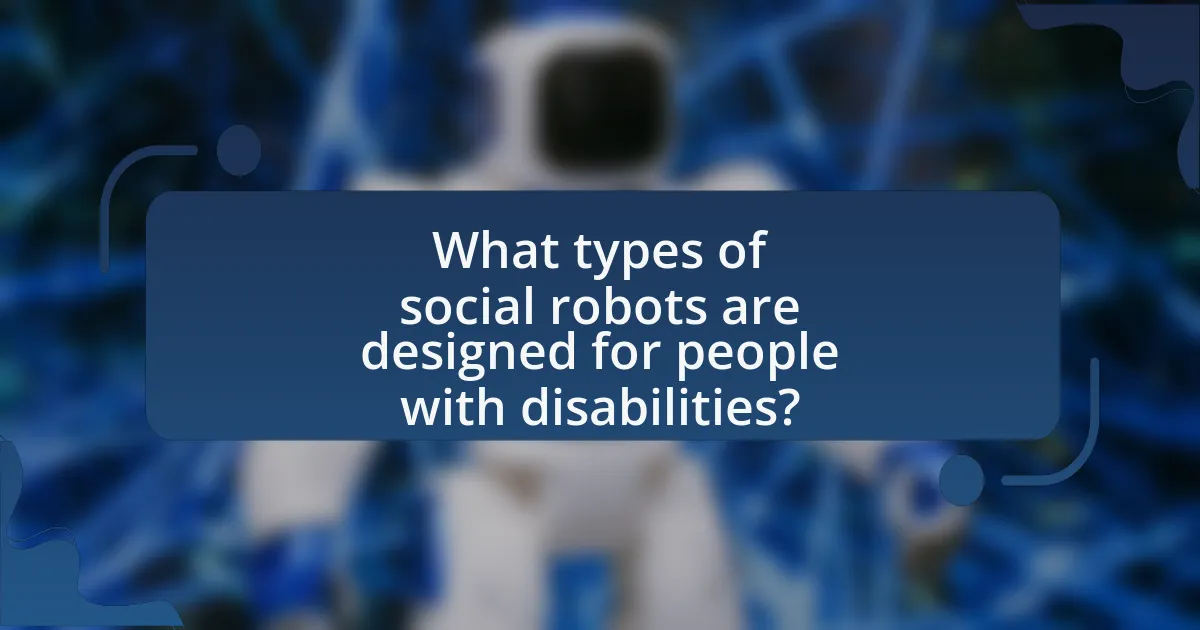
What types of social robots are designed for people with disabilities?
Social robots designed for people with disabilities include companion robots, assistive robots, and communication robots. Companion robots, such as Paro and Aibo, provide emotional support and companionship, which can enhance the quality of life for individuals with social interaction challenges. Assistive robots, like robotic arms and mobility aids, help with daily tasks, promoting independence for those with physical disabilities. Communication robots, such as those equipped with speech-generating devices, facilitate interaction for individuals with speech impairments. These robots are developed based on research indicating their effectiveness in improving social engagement, autonomy, and overall well-being for people with disabilities.
What are the different categories of social robots available?
The different categories of social robots available include companion robots, service robots, educational robots, and therapeutic robots. Companion robots, such as Aibo and Paro, are designed to provide emotional support and companionship. Service robots, like Pepper and Jibo, assist with tasks in various environments, including homes and healthcare settings. Educational robots, such as LEGO Mindstorms and Dash, facilitate learning and engagement in educational contexts. Therapeutic robots, including robotic pets and humanoid robots, are utilized in therapy to aid individuals with disabilities in social interaction and emotional development. Each category serves distinct purposes, contributing to the overall goal of enhancing social interaction and inclusivity for people with disabilities.
How do companion robots differ from assistive robots?
Companion robots primarily focus on providing emotional support and companionship, while assistive robots are designed to aid individuals in performing specific tasks or activities. Companion robots, such as social robots, engage users through conversation and interaction, enhancing social well-being, whereas assistive robots, like mobility aids or robotic arms, facilitate physical tasks, improving independence and functionality. The distinction lies in their primary objectives: emotional connection versus task assistance, which is crucial in understanding their roles in promoting inclusivity for people with disabilities.
What features make social robots effective for people with disabilities?
Social robots are effective for people with disabilities due to their ability to provide personalized interaction, assistive technology integration, and emotional support. Personalized interaction allows social robots to adapt their communication styles and responses based on individual user needs, enhancing engagement and understanding. Assistive technology integration enables these robots to facilitate daily tasks, such as reminders for medication or assistance with mobility, thereby promoting independence. Emotional support is provided through companionship and social interaction, which can reduce feelings of isolation and improve mental well-being. Research indicates that social robots can significantly enhance the quality of life for individuals with disabilities by fostering social connections and providing practical assistance.
How are social robots developed to meet the needs of individuals with disabilities?
Social robots are developed to meet the needs of individuals with disabilities through a combination of user-centered design, adaptive technology, and collaborative research. User-centered design involves engaging individuals with disabilities in the development process to ensure that the robots address their specific needs and preferences. Adaptive technology allows robots to modify their behavior based on the user’s abilities, such as adjusting communication styles for those with hearing impairments or providing physical assistance for mobility challenges. Collaborative research, often involving interdisciplinary teams of engineers, psychologists, and healthcare professionals, ensures that the robots are effective and beneficial. For instance, studies have shown that social robots can improve social interaction and emotional well-being among individuals with autism, demonstrating their potential to enhance quality of life.
What role does user feedback play in the design of social robots?
User feedback is crucial in the design of social robots as it directly informs the development process, ensuring that the robots meet the needs and preferences of users, particularly those with disabilities. By collecting and analyzing feedback from users, designers can identify specific functionalities that enhance usability and accessibility, leading to more effective interactions. For instance, studies have shown that incorporating user feedback can improve the emotional responsiveness of social robots, making them more relatable and supportive for individuals with disabilities. This iterative design approach not only enhances user satisfaction but also fosters a sense of ownership and empowerment among users, ultimately promoting inclusivity.
How do developers ensure accessibility in social robot technology?
Developers ensure accessibility in social robot technology by incorporating universal design principles, which focus on creating products usable by all individuals, regardless of their abilities. This includes implementing features such as voice recognition for users with mobility impairments, customizable interfaces for those with visual impairments, and social interaction capabilities that accommodate various communication styles. Research indicates that 15% of the global population experiences some form of disability, highlighting the necessity for inclusive design in technology. By adhering to accessibility standards, such as the Web Content Accessibility Guidelines (WCAG), developers can create social robots that effectively serve diverse user needs, thereby promoting inclusivity for people with disabilities.

What are the challenges faced by social robots in promoting inclusivity?
Social robots face several challenges in promoting inclusivity, primarily related to design, user interaction, and societal perceptions. The design of social robots often lacks adaptability to diverse user needs, making it difficult for individuals with varying disabilities to engage effectively. Additionally, user interaction can be hindered by limited communication capabilities, which may not accommodate all forms of expression or understanding, particularly for those with cognitive impairments. Societal perceptions also pose a challenge, as biases and misconceptions about disabilities can affect the acceptance and integration of social robots in inclusive settings. These challenges highlight the need for ongoing research and development to enhance the effectiveness of social robots in fostering inclusivity for people with disabilities.
What limitations do social robots currently have?
Social robots currently have limitations in emotional understanding, adaptability, and physical interaction. These robots often struggle to accurately interpret human emotions, which hinders their ability to respond appropriately in social contexts. For instance, a study by Breazeal et al. (2016) highlights that social robots lack the nuanced understanding of human emotional cues, leading to ineffective communication. Additionally, their adaptability to diverse environments and individual needs is limited; many robots are programmed for specific tasks and cannot easily adjust to new situations or user preferences. Furthermore, physical interaction capabilities are often restricted, as many social robots are not designed to perform complex tasks that require fine motor skills or to navigate dynamic environments effectively. This combination of emotional, adaptive, and physical limitations restricts the potential of social robots in promoting inclusivity for people with disabilities.
How do technological barriers affect the effectiveness of social robots?
Technological barriers significantly hinder the effectiveness of social robots by limiting their functionality and user interaction capabilities. For instance, inadequate natural language processing can lead to misunderstandings between the robot and users, particularly those with disabilities who may rely on clear communication. Additionally, limited sensor technology can restrict a robot’s ability to perceive and respond to its environment, which is crucial for providing assistance to individuals with varying needs. Research indicates that social robots with advanced technology, such as improved AI algorithms and better sensory equipment, demonstrate higher engagement and satisfaction rates among users, thereby enhancing their overall effectiveness in promoting inclusivity for people with disabilities.
What ethical considerations arise in the use of social robots for people with disabilities?
The ethical considerations in the use of social robots for people with disabilities include issues of autonomy, privacy, and the potential for dependency. Autonomy is compromised when social robots make decisions on behalf of individuals, potentially undermining their independence. Privacy concerns arise from the data collection practices of these robots, which may track personal information without consent. Additionally, the risk of dependency on social robots can lead to diminished human interaction, impacting social skills and emotional well-being. These considerations are critical as they directly affect the quality of life and dignity of individuals with disabilities.
How can social robots be improved to better serve individuals with disabilities?
Social robots can be improved to better serve individuals with disabilities by enhancing their adaptability, communication capabilities, and user-centered design. Enhancing adaptability involves programming robots to recognize and respond to diverse needs, such as mobility assistance or sensory impairments, which can be achieved through machine learning algorithms that learn from user interactions. Improving communication capabilities includes integrating natural language processing and emotional recognition technologies, allowing robots to engage in meaningful conversations and respond empathetically to users’ emotional states. User-centered design focuses on involving individuals with disabilities in the development process, ensuring that robots are tailored to their specific requirements and preferences. Research indicates that user involvement in design leads to more effective and accepted technologies, as seen in studies like “Designing Social Robots for People with Disabilities” by Fong et al., which highlights the importance of user feedback in creating functional and supportive robotic systems.
What advancements in technology could enhance social robots’ capabilities?
Advancements in artificial intelligence, machine learning, and natural language processing could significantly enhance social robots’ capabilities. These technologies enable robots to better understand and respond to human emotions, improving their interaction quality. For instance, AI algorithms can analyze facial expressions and vocal tones, allowing robots to adapt their behavior to provide more empathetic responses. Additionally, advancements in sensor technology and robotics can improve mobility and dexterity, enabling robots to assist individuals with disabilities more effectively. Research indicates that integrating these technologies can lead to more personalized and supportive interactions, ultimately fostering inclusivity for people with disabilities.
How can collaboration with disability advocacy groups improve social robot design?
Collaboration with disability advocacy groups can significantly enhance social robot design by ensuring that the needs and preferences of individuals with disabilities are directly integrated into the development process. This partnership allows designers to gain firsthand insights into the challenges faced by users, leading to more intuitive and accessible robot functionalities. For instance, research has shown that involving users with disabilities in the design phase can result in products that better accommodate diverse physical and cognitive abilities, ultimately improving user satisfaction and effectiveness.
What best practices should be followed when implementing social robots for inclusivity?
To implement social robots for inclusivity effectively, it is essential to prioritize user-centered design, ensuring that the robots are accessible and usable for individuals with diverse abilities. This involves conducting thorough user research to understand the specific needs and preferences of people with disabilities, which can guide the development of features that enhance interaction and engagement. For instance, incorporating voice recognition and customizable interfaces can accommodate various communication styles and preferences.
Additionally, continuous testing and feedback loops with users during the development process are crucial to refine functionalities and ensure that the robots meet the intended inclusivity goals. Research indicates that involving end-users in the design process significantly improves the usability and acceptance of technology among people with disabilities (Shinohara & Tenenberg, 2018, “The Role of User Involvement in the Design of Assistive Technology,” Journal of Assistive Technologies).
Furthermore, providing comprehensive training and support for both users and caregivers can enhance the effectiveness of social robots in promoting inclusivity. This approach ensures that all stakeholders are equipped to utilize the technology effectively, fostering a more inclusive environment.
